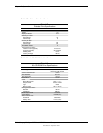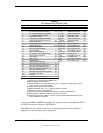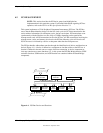
Technical Reference Guide
Compaq Deskpro 4000N and 4000S Personal Computers
First Edition - September 1997
3-5
3.2.4 SYSTEM MEMORY
The system board contains two 168-pin DIMM sockets for system memory. This system is
designed for using SDRAM DIMMs. As shipped from the factory the standard configuration may
be 16 or 32 megabytes installed. The addition of 16-, or 32-, 64-, or 128-MB DIMMs allows the
expansion of system memory up to a maximum of 256 megabytes. Single or double-sided
DIMMs may be used. It is strongly recommended to use DIMMs with gold-plated contacts.
The system memory uses the following RAS line assignments:
RAS#0 DIMM 1, Bank A
RAS#1 DIMM 1, Bank B
RAS#2 DIMM 2, Bank A
RAS#3 DIMM 2, Bank B
This system does not use parity but does support ECC, and the memory is unbuffered. The
performance times of the SDRAM is listed as follows:
Table 3–4.
SDRAM Performance Times
Table 3-4.
SDRAM Performance Times
Parameter CAS Latency = 2 CLKs
Burst Read Page Hit: 6-1-1-
Read Row Miss 8-1-1-1
Read Page Miss 10-1-1-1
Bk-to-Bk Burst Reads (Pg Hit ) 6-1-1-1, 3-1-1-1
Write Page Hit 3
Write Row Miss 6
Write Page Miss 9
Posted Write 3-1-1-1
In addition to the supplied (and recommended) SDRAM, the system supports EDO and ECC
RAM, with error logging/alerting supported. The RAM type (as well as other information) is
detected during power-up by the system BIOS using the serial presence detect (SPD) method,
which reads the EEPROM on each DIMM to obtain identification data such as the type and
operating parameters. The supported format complies to the JEDEC specification for 128-byte
EEPROMs. This system also provides support for 256-byte EEPROMs to include additional
Compaq-added features such as the part number, serial number, and error logging. The SPD
format as supported in this system is shown in Table 3-5.


















